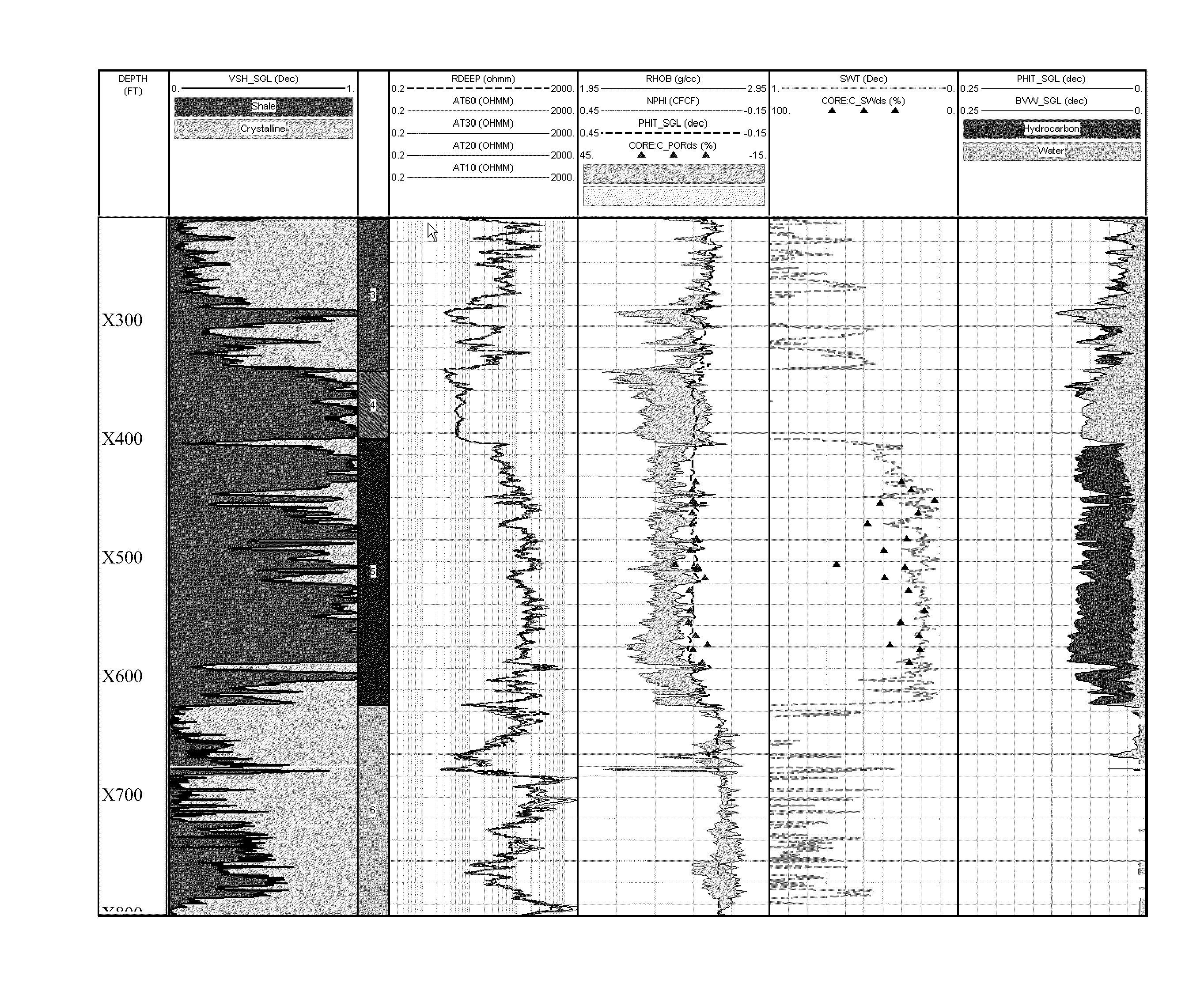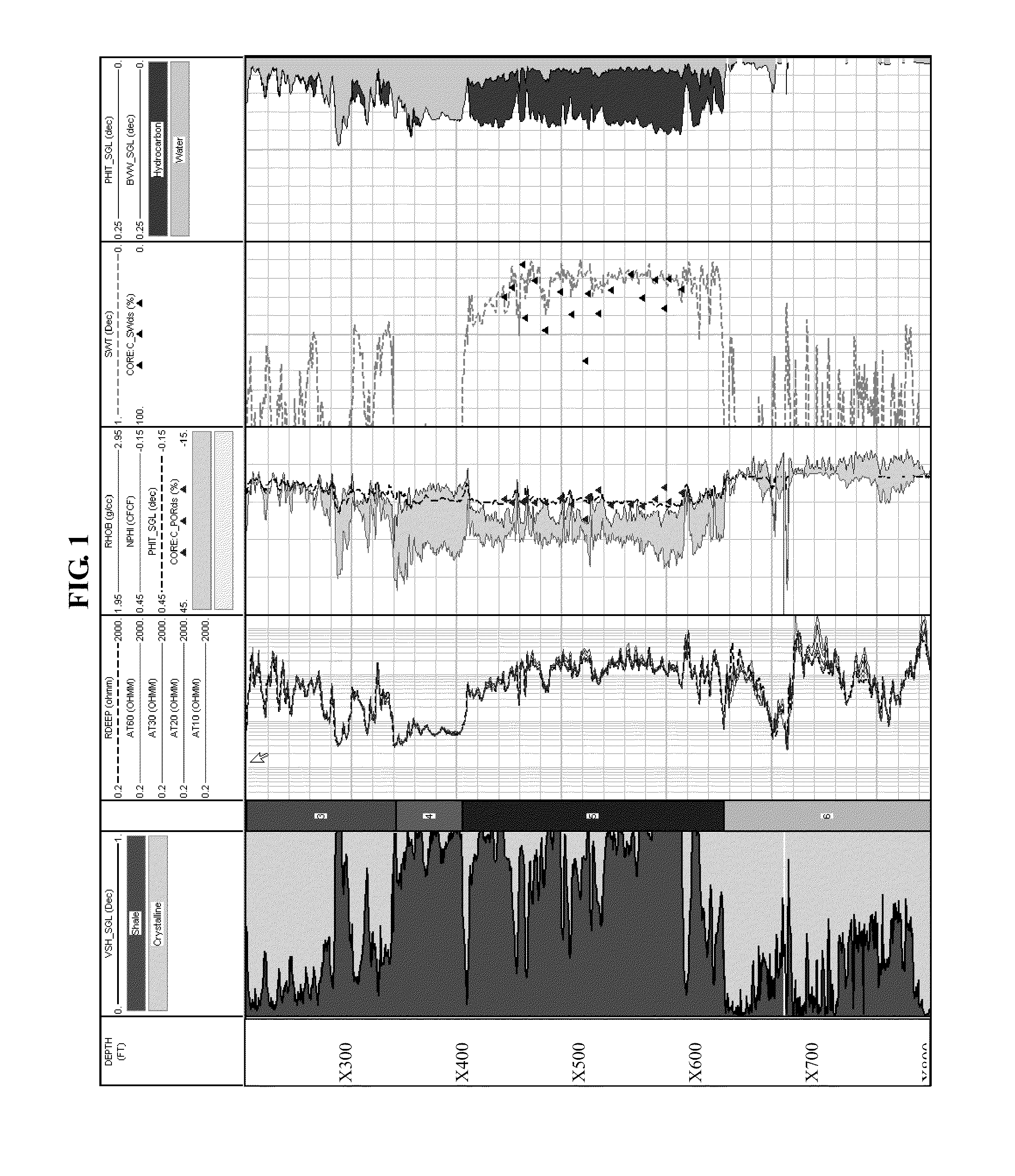Source rock volumetric analysis
a source rock and volumetric analysis technology, applied in the field of source rock volumetric analysis, can solve the problems of increasing the difficulty of determining the required empirical parameters in unconventional reservoirs, increasing the difficulty of determining the required empirical parameters, and increasing the difficulty of determining the formation water resistivity, so as to reduce or eliminate the erroneous toc values, increase the compressional slowness of source rocks, and competitive advantage
- Summary
- Abstract
- Description
- Claims
- Application Information
AI Technical Summary
Benefits of technology
Problems solved by technology
Method used
Image
Examples
example 1
Non-Conventional Reservoir
[0055]As shown in FIGS. 3-6, using single well-bore at three or more locations within the formation, resistivity was measured and used to calculate GR, porosity, Volume, Rho, TOC, and other properties of Formation I-V.
[0056]Many complex mineralogy scenarios must be accounted for to obtain an accurate measurement of saturation, porosity, resistivity, and TOC. Substantial mineral density variation, i.e. pyrite of about 5 g / cc and clay at about 2.1-2.9 g / cc, indicates that formation density measurements across all mineral types will be difficult. Additionally, kerogen formations present different problems because kerogen is not crystalline and at about 1.25 g / cc, dramatically affects standard porosity / resistivity calculations. To overcome this, our system uses standard measurements, frequently measured during routine well bore logging, to calculate throughout the formation, resistivity and porosity for non-standard, unconventional porous media including source...
example 2
Saturation Evaluation
[0058]An algorithm was developed to automate the SW, porosity, resistivity and TOC calculations in situ using existing or a minimal amount of well log data. Special runs are typically not required when calculating SW using the present algorithm. By plotting resistivity vs. compressional slowness, a regression representing SW=100% is used to determine the R0 for all non-reservoir rocks. Other plots including porosity, sonic-porosity, and the like may be used for regression analysis dependent upon the data available and accuracy of the measurements. Water saturation for the entire reservoir is calculated using Archie's 1941 calculation. The regression results can be verified using standard measures of distribution, error, and mode. This calculated SW and R0 can be used in a variety of equations to determine RW, φ, VSH, TOC, ΔLogR, and other related properties.[0059]1. Locate the trend in a cross plot of resistivity vs. compressional slowness that represents the ab...
example 3
Comparing Core Data
[0096]As shown in FIGS. 3-6, a variety of formation types were analyzed using resistivity measurements. Note that in each case the calculated saturation, volume, porosity, and TOC were near actual well-bore data and accurately depicted TOC values that could be used to begin drilling and production.
[0097]In one embodiment, a software algorithm operable to a database containing subterranean formation characteristics, would produce volumetric information for each well including but not limited to, water saturation, porosity, total organic carbon, and shale volume.
[0098]SW calculations are shown for Formation I (FIG. 3), Formation II (FIG. 4), Formation III (FIG. 5), and Formation IV (FIG. 6). Even with the variety of conditions described in FIGS. 3-6, the saturation evaluation described in Example 2, provides a more accurate and complete analysis of the formations being analyzed. As seen from the core data, the hydrocarbon content can be accurately determined with a ...
PUM
 Login to View More
Login to View More Abstract
Description
Claims
Application Information
 Login to View More
Login to View More - R&D
- Intellectual Property
- Life Sciences
- Materials
- Tech Scout
- Unparalleled Data Quality
- Higher Quality Content
- 60% Fewer Hallucinations
Browse by: Latest US Patents, China's latest patents, Technical Efficacy Thesaurus, Application Domain, Technology Topic, Popular Technical Reports.
© 2025 PatSnap. All rights reserved.Legal|Privacy policy|Modern Slavery Act Transparency Statement|Sitemap|About US| Contact US: help@patsnap.com



